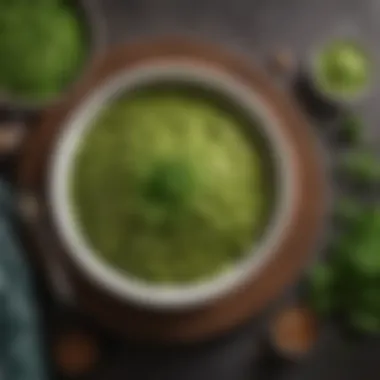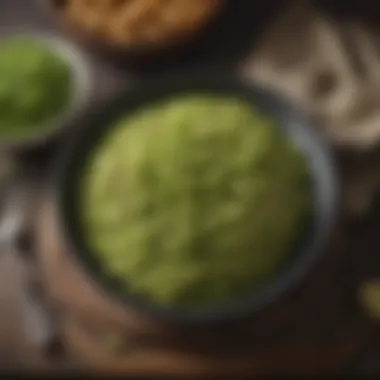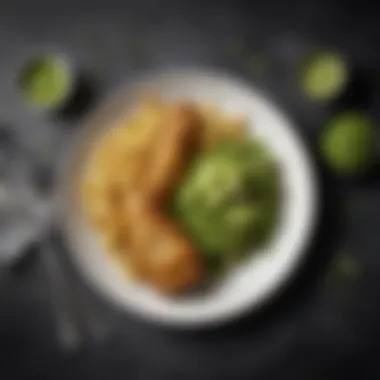Exploring British Mushy Peas: Tradition and Technique


Intro
British mushy peas are far more than just a simple side dish; they represent a cultural staple that has been deeply rooted in British culinary tradition for centuries. Characterized by their soft, green texture and vibrant color, mushy peas can elevate many meals, especially classic fish and chips. This exploration aims to uncover the historical significance of mushy peas within the United Kingdom while diving into various preparation techniques, nutritional aspects, and how modern culinary enthusiasts have adapted them in contemporary kitchens.
The journey begins with understanding what exactly mushy peas are. They typically consist of marrowfat peas, which are soaked and cooked until they reach a creamy consistency. At their core, mushy peas embody a sense of comfort and nostalgia for many Brits. Their common pairing with traditional dishes speaks volumes about their role in British gastronomy. By delving deeper into their origins, we can appreciate the seamless blend of tradition and technique that this dish embodies.
As we navigate through this article, we will analyze distinct recipes, ingredient substitutions for those with dietary restrictions, and the overall nutrition of mushy peas. This will not only enhance comprehension among food lovers but also encourage home cooks to experiment with this versatile dish.
"Mushy peas often serve as a reminder of simpler times, where food traditions were nurtured through generations."
This comprehensive guide aims to shed light on this humble yet significant dish, paving the way for both culinary enthusiasts and novice cooks to understand and appreciate the art of preparing mushy peas.
Preface to British Mushy Peas
Mushy peas are an integral part of British cuisine, often regarded as a quintessential side dish. This article aims to explore the significance of mushy peas within the wider context of British culinary heritage. Understanding their origins and cultural implications can enrich one’s appreciation of this traditional dish. Many individuals may recognize mushy peas primarily as a complement to fish and chips, yet their history and versatility stretch beyond mere accompaniment.
Origin and Cultural Significance
The origins of mushy peas trace back to England, where they have been a staple since at least the 19th century. They are made from marrowfat peas, which are dried and soaked before cooking. This approach creates a creamy and smooth texture that pairs well with various dishes. The dish is considered nostalgic for many Brits, recalling memories of family meals and traditional pubs.
In terms of cultural significance, mushy peas reflect the British emphasis on comfort food. They represent simplicity and nourishment during challenging times. Over the decades, mushy peas have been associated with working-class meals, showcasing the rich tapestry of British food culture. They symbolize resilience and practicality in British cooking.
Traditional Pairings with British Dishes
Mushy peas are commonly paired with several traditional British dishes, enhancing the overall dining experience. Fish and chips is perhaps the most famous combination. The softness of the peas complements the crispy texture of the fried fish beautifully. Other typical pairings include:
- Bangers and Mash: The dish consisting of sausages and mashed potatoes is often served with a side of mushy peas, creating a hearty meal.
- Pie and Mash: In many London shops, mushy peas are served alongside meat pies and mashed potatoes, adding both color and texture to the plate.
- Ploughman’s Lunch: Many enjoy mushy peas in a ploughman’s lunch, where they join cheese, pickles, and bread.
These pairings highlight how mushy peas can enhance a meal’s flavor profile. The dish itself is versatile and adaptable to various culinary contexts, making it a beloved item on menus across the UK. The simplicity of mushy peas allows for unique interpretations, with chefs and home cooks alike experimenting with flavors, while remaining true to their traditional roots.
History of Mushy Peas
The history of mushy peas is a vital aspect of understanding their place in British cuisine. This section uncovers their origins and adaptations over time, revealing how this dish evolved into a staple side that many associate with comfort and tradition. The nostalgic quality of mushy peas stems from their deep-rooted connection to British culture, revealing societal changes and culinary trends.
Early Beginnings in British Cuisine
Mushy peas likely trace their roots back to the 18th century in England. They were originally made from the marrowfat pea, which became popular due to its ability to be dried and stored for longer periods. This made the peas an essential food source, especially for the working class. During this time, pea soup was widely consumed, and the first iterations of mushy peas appeared as a way to prepare and enjoy this versatile legume.
Peas were not just important for sustenance; they held a unique position in British society. During agriculture seasons, peas were often a significant part of the diet, especially for those who worked on farms. Furthermore, the simplicity of mashing the peas showed the innately practical nature of British cooking.
Evolution Through the Centuries
As the centuries passed, the culinary preferences of the British evolved, yet mushy peas remained a constant symbol of tradition. In the 19th century, they became increasingly popular as the industrial revolution progressed. Factories and urban living emerged, making time-efficient meals crucial for workers. The appeal of mushy peas grew as they complemented fish and chips, a quintessential British dish.
Various techniques for preparation also emerged during this phase. Home cooks developed methods to achieve the perfect consistency, often mashing or blending the peas by hand. Recipes began circulating in cookbooks, contributing to the standardization of mushy peas. In context, they became part of meals served in pubs and fish-and-chip shops across the UK.
Mushy Peas in Modern Times
In the contemporary gastronomic landscape, mushy peas have found a renewed popularity, not just as a side dish but also as a culinary canvas for experimentation. Chefs are reimagining mushy peas with herbs, spices, and additional ingredients, appealing to an audience that seeks novelty without losing sight of tradition. The dish's health benefits are being highlighted, as peas are packed with protein and fiber.
Today, mushy peas still serve their purpose as a side at rustic dinners and family gatherings. Whether enjoyed alongside traditional fish and chips or reinvented in new culinary formats, they remain a signature element of British identity. The endurance of mushy peas illustrates how this dish adapts with society, reflecting broader trends while keeping a firm grip on heritage.
Mushy peas represent resilience and adaptability, encapsulating the essence of British culinary tradition.
In summary, the history of mushy peas is not just a tale of a simple side dish; it is an exploration of cultural evolution, highlighting how traditional foods can endure and adapt throughout the ages.
Nutritional Value of Mushy Peas
Understanding the nutritional value of mushy peas is critical for evaluating their role in a balanced diet. This section delves into the specific health benefits of peas and their breakdown of calories and macronutrients. By comprehending their nutritional benefits, consumers can appreciate why mushy peas have maintained a place in British cuisine.
Health Benefits of Peas


Mushy peas are not merely a side dish; they come packed with beneficial nutrients. These peas are legumes and offer numerous health advantages:
- Rich in Protein: Peas contain essential amino acids, making them a good protein source for vegetarians and vegans. Incorporating peas into meals can aid muscle repair and growth.
- Load of Fiber: High fiber content in mushy peas promotes digestive health. It helps regulate bowel movements and may play a role in reducing cholesterol levels.
- Vitamins and Minerals: Mushy peas provide vital vitamins such as vitamin A, C, and K. These vitamins are fundamental for immune function, skin health, and blood clotting.
- Low Glycemic Index: With a low glycemic index, mushy peas can stabilize blood sugar levels, making them suitable for individuals managing diabetes.
- Antioxidant Properties: Peas contain antioxidants, which combat oxidative stress in the body and may lower the risk of chronic diseases.
"Eating peas can provide vital nutrients that support overall health and well-being."
Caloric and Macronutrient Breakdown
A close look at the caloric and macronutrient content of mushy peas reveals their suitability for various dietary plans:
- Calories: A typical serving size of mushy peas (around 100 grams) contains approximately 80 calories, allowing for a low-calorie addition to meals.
- Carbohydrates: This serving has about 14 grams of carbohydrates, contributing energy while being relatively low in sugar.
- Proteins: Peas provide around 5 grams of protein per serving, enhancing their value as a plant-based protein source.
- Fats: Notably low in fat, mushy peas have less than 1 gram of fat per serving, making them a heart-healthy option.
The balance of these macronutrients makes mushy peas not just a traditional dish but also a nutritious one. Thus, incorporating them into a diet can be beneficial for those seeking good nutrition without excessive calories.
Ingredients Used in Mushy Peas
Ingredients play a pivotal role in the preparation of mushy peas. The choice of peas significantly influences the final texture and flavor. Selecting the right type of pea is essential for achieving the desirable characteristics of this traditional dish. Additionally, the seasoning and flavor enhancements can elevate the taste profile, making it more appealing.
Types of Peas Best Suited for Mushing
When it comes to making mushy peas, the type of pea used is of utmost importance. The most commonly used varieties include:
- Marrowfat peas: These are the traditional choice for mushy peas. They are larger and have a starchy texture that mashes well, creating that creamy consistency. The distinctive flavor of marrowfat peas is a hallmark of authentic mushy peas.
- Green peas: While not the classic option, green peas can also be used. They are slightly sweeter and lend a different flavor. Fresh green peas provide a vibrant color and fresh taste.
- Dried peas: Dried marrowfat peas, when soaked and cooked properly, can yield results similar to their canned counterparts. They require more time but offer a more robust flavor.
Choosing the right peas is more than just a matter of tradition; it impacts the overall experience of the dish.
Seasoning and Flavor Enhancement
Once the right type of peas is selected, seasoning becomes the next critical step. Mushy peas often have a simple ingredient list, but the addition of seasonings can enhance their flavor significantly. Common seasonings include:
- Salt: A primary seasoning to bring out the natural flavor of the peas.
- Pepper: Freshly cracked pepper adds warmth and complexity.
- Mint: This is a traditional herb used in British cuisine. Chopped fresh mint can add a refreshing note to the dish, contrasting nicely with the earthy peas.
- Butter: Adding butter gives richness and a creamy texture. Some prefer using salted butter for extra flavor.
- Onion powder: This can contribute depth without the strong taste of raw onions.
For those looking to experiment, flavor infusions such as garlic or lemon can add unique dimensions. The key is to balance flavors while maintaining the signature essence of mushy peas.
"The choice of peas and seasonings can make or break the experience of mushy peas, emphasizing the importance of selection in this traditional dish."
Incorporating these ingredients mindfully will ensure that the dish resonates with both authenticity and flavor.
Classic Preparation Methods
Understanding the classic preparation methods for mushy peas is essential for anyone looking to appreciate this traditional dish fully. Mushy peas are not just a simple side; they represent a craftsmanship that has been passed down through generations. These methods ensure that the peas maintain their texture and flavor while offering a comforting addition to a meal.
Traditional Cooking Techniques
Traditional cooking of mushy peas involves several key steps. First, the right type of peas is crucial. Traditionally, marrowfat peas are used because of their starchy content, which aids in achieving the desired mushy consistency. These peas are often soaked overnight. Soaking helps to soften the peas, allowing them to break down more easily during cooking.
Once soaked, the peas are drained and then boiled in fresh water. This boiling process usually lasts for about an hour, or until the peas are tender. After boiling, the peas are drained again, and then it is time to mash them. This can be done using a masher or a fork, depending on how smooth one prefers the final product. When mashing, it is essential to incorporate some butter or a form of fat. This addition enhances the richness of the dish.
Important considerations include monitoring the cooking time closely. Overcooked peas can lead to a more unappetizing mush, while undercooked peas may remain too firm. Adjusting the water during cooking is also vital. It should not be too much, as the residual water contributes to the final texture and moisture of the dish.
“Mushy peas have a texture and flavor that reflect the cooking methods used; proper techniques can elevate a humble ingredient into a splendid dish.”
Modern Adaptations and Techniques
Modern adaptations of mushy peas take the traditional foundation and expand upon it. With the rise of culinary creativity, many chefs and home cooks alike are experimenting with flavors. For instance, while some adhere to the classic preparation, others introduce modern appliances like food processors or immersion blenders for a smoother finish. This method is quicker and can achieve a desirable consistency in less time.
In addition to new tools, seasonings are also evolving. For example, while butter still reigns supreme, several cooks opt for olive oil or flavored oils to introduce different taste profiles. Herb and spice additions are common in contemporary recipes. Popular choices include garlic, mint, or even chili for a bit of heat.
The nutritional awareness in recent years has led some to explore plant-based alternatives. Using vegetable broth instead of water adds additional flavors while maintaining a vegetarian appeal. Moreover, lighter preparations that reduce fat or salt content are becoming more common, catering to a health-conscious audience. These adaptations ensure that mushy peas remain relevant in modern cuisine, appealing to both traditionalists and new generations of food enthusiasts.
Recipes for Homemade Mushy Peas


The section dedicated to recipes for homemade mushy peas is essential in understanding not just how to prepare this classic side dish, but also the variations that enhance its appeal. Recipes provide a way for culinary enthusiasts to engage with the dish authentically, using methods that respect tradition while also allowing for personal creativity. Both seasoned cooks and beginners can benefit from a reliable recipe that guides them through the process, ensuring the right texture and flavor balance.
Cooking mushy peas at home allows the individual to control the ingredients, catering to specific dietary preferences and flavor profiles. Additionally, preparing this dish from scratch can be a more economical choice compared to pre-packaged options, making it an accessible pursuit for all. The interactivity offered by recipe exploration fosters a deeper connection to British culinary heritage, showcasing the humble pea's versatility.
Classic Mushy Peas Recipe
The traditional classic mushy peas recipe emphasizes simplicity, allowing the flavor of the peas to shine. To prepare this dish, the primary ingredients are dried marrowfat peas, water, and salt. For a richer taste, a bit of butter or oil can be added.
Ingredients:
- 500g dried marrowfat peas
- Water
- Salt to taste
- Optional: Butter or oil
Instructions:
- Soak the Peas: Rinse the dried peas and soak them in plenty of water overnight. This softens them, speeding up the cooking process.
- Cook the Peas: Drain the peas and place them in a pot with fresh water. The water level should be several inches above the peas.
- Simmer: Bring to a boil, then reduce heat and let it simmer. Cook for 1 to 1.5 hours or until the peas are soft and begin to break down.
- Mash: Once cooked, drain excess water if necessary, and mash the peas. The texture can be adjusted based on preference—some prefer them smoother, while others enjoy a bit of chunkiness.
- Season: Add salt and any optional ingredients like butter or oil. Mix well and serve warm.
This recipe provides a solid foundation for anyone looking to start their adventure with mushy peas.
Variations and Flavor Infusions
Exploring variations and flavor infusions for mushy peas brings unique tastes to this traditional dish. By adding different herbs and spices, cooks can tailor the dish to complement various meals.
Mint Variations
Incorporating mint into mushy peas provides a refreshing twist that can enhance the overall eating experience. The key characteristic of mint variations is their ability to add brightness and contrast to the earthiness of the peas.
Benefits: Mint is not only flavorful but also known for its digestive properties, making this infusion a wise choice for those seeking health benefits alongside taste. The sumptuously vibrant green of mint also adds a visual component that elevates the dish.
Unique Features: This infusion pairs particularly well with fish dishes, enhancing flavors without overpowering them. However, some may find mint too dominant if used excessively.
Garlic and Lemon Infusion
Adding garlic and lemon infuses a savory and citrusy profile into mushy peas, turning a simple dish into a more sophisticated offering. The standout characteristics lie in the boldness of garlic combined with the acidity of lemon, which helps brighten the dish significantly.
Benefits: Both garlic and lemon are celebrated for their health benefits. Garlic supports the immune system, while lemon provides vital vitamin C. This infusion not only elevates flavor but also introduces nutritional advantages.
Unique Features: This variation works well with a range of meats and can particularly enhance grilled items. However, one must balance the flavors to avoid overpowering the delicate taste of the peas.
Serving Suggestions
The section on Serving Suggestions is crucial in helping readers appreciate the versatility of mushy peas. This traditional dish often pairs well with a range of British meals, enhancing flavors and creating balanced plates. Understanding how to serve mushy peas can elevate a simple dinner into an enjoyable culinary experience.
Complementary Dishes
Mushy peas have a long history of being enjoyed alongside various British dishes. They are particularly well-known as a side for fish and chips. The slight sweetness of the peas contrasts nicely with the crispy batter of the fish.
Other dishes that complement mushy peas include:
- Bangers and Mash: The creamy texture of the mashed potatoes pairs perfectly with mushy peas, creating a hearty meal that is comforting and satisfying.
- Shepherd's Pie: The rich flavors of this dish become even richer with a serving of mushy peas on the side. It adds a fresh and light component.
- Meat Pies: Whether it’s a steak and kidney pie or a chicken pie, mushy peas provide a vegetal counterpoint that lightens the meal.
- Grilled Sausages: The smoky and savory qualities of grilled sausages are nicely tempered by the simple flavor of mushy peas.
Incorporating mushy peas alongside these dishes not only enhances the taste of the meal but also brings a classic touch to dinner plates.
Creative Presentation Techniques
Presentation may significantly impact the dining experience, even with a humble dish like mushy peas. Creative presentation can transform how people perceive and enjoy this traditional food.
Here are several methods to enhance the visual appeal of mushy peas:
- Use of Bowls: Serve mushy peas in rustic or colorful bowls. This adds an element of charm that draws attention to the dish.
- Layering: In some cases, mushy peas can be layered in a small glass with other ingredients like pickled vegetables or diced tomatoes to create a visually appealing effect.
- Garnishing: Sprinkling fresh parsley or minced mint on top can add a pop of color and freshness. The vibrant green colors will enhance the dish's aesthetic.
- Serving with a Twist: Consider serving mushy peas in a filo pastry shell or as a filling in a small tart to create a unique starter.
Engaging presentation not only makes the dish more appetizing but can also impress guests, making it a memorable part of their dining experience.


Mushy Peas in Popular Culture
Mushy peas are more than just a simple side dish in the United Kingdom; they embody a rich tapestry of cultural significance and culinary identity. Their presence in popular culture underscores not only their relevance in British cuisine but also how they connect with identity, nationality, and even social commentary. This section explores how mushy peas have found their place in various media and contribute to the understanding of British culinary traditions.
Representations in Media
Mushy peas often appear in various forms of media, serving as both a humorous commentary on traditional British food and a nostalgic nod to the country’s culinary heritage. From television shows to films, these bright green peas symbolize comfort food and simplicity.
In humorous British sitcoms, references to meals like "fish and chips with mushy peas" often evoke a sense of familiarity among audiences. This common pairing not only highlights culinary practices but also brings to light regional pride in British comfort food.
Furthermore, food-related documentaries have placed mushy peas in the spotlight, examining their historical significance and nutritional value. These representations help people understand the dish's fundamental role in British heritage. Documentaries like The Big Lamb Eddy cover how traditional meals evolve, sometimes spurring debate about what truly represents British cuisine.
"Mushy peas capture a sense of nostalgia for many, reflecting both regional flavors and the evolution of British food culture."
Mushy Peas and Culinary Identity
The concept of culinary identity is tied closely to national pride, and mushy peas are often at the center of this discussion. As a quintessential side dish in the UK, they reflect a cultural landscape shaped by both historical events and everyday life.
Dish like mushy peas have a unique status. They act as a representation of working-class food, symbolizing sustenance during times of economic hardship, particularly during the post-war era. Their revival in contemporary settings, such as gourmet restaurants, has turned them into a subject of curiosity.
Moreover, the embrace of mushy peas in various cooking styles—from traditional English fish and chips to modern fusion dishes—demonstrates the dynamic nature of identity within cuisine. This evolution highlights how traditional dishes can adapt, yet still retain their essence, creating a bridge between the past and present.
In short, mushy peas not only nourish the body, but they also foster a sense of belonging and tradition within the British culinary landscape.
Contemporary Trends and Innovations
Contemporary trends in the culinary world often reflect a desire for innovation while respecting tradition. In the context of British mushy peas, this dish, once a humble side, is increasingly being reimagined and integrated into modern cuisine. This evolution is marked by a few specific elements that provide distinct benefits to both chefs and diners.
One significant trend is the fusion of traditional mushy peas with global flavors. Chefs are experimenting with spices and ingredients from diverse culinary backgrounds to create unique taste profiles. This reflects a broader gastronomic movement where cultural boundaries in food begin to blur, presenting a more eclectic dining experience.
In addition, presentation techniques are evolving. The pasty green mash commonly served alongside fish and chips is now adorned with vibrant herbs or presented in elegant bowls. This shift emphasizes the aesthetic value of the dish, appealing not only to taste but also to visual senses.
Reimagining Mushy Peas in Modern Cuisine
The approach to mushy peas is undergoing a remarkable transformation. Restaurants are exploring inventive recipes that incorporate this classic dish into gourmet settings. For example, chefs often pair mushy peas with unexpected ingredients.
Some popular ideas include:
- Curry-infused mushy peas – Adding curry powder or paste can introduce an exciting flavor that complements meat dishes.
- Mushy peas with truffle oil – This luxurious addition elevates the traditional dish, making it appropriate for high-end dining.
- Pea puree with mint or basil – Fresh herbs can enhance the freshness of mushy peas, appealing to modern palates that favor lighter, herbaceous flavors.
These innovative takes not only promote the versatility of mushy peas but also encourage diners to revisit and appreciate this age-old side dish.
Plant-Based Alternatives in Dishes
As the culinary landscape embraces plant-based diets, mushy peas find themselves well-aligned with the principles of this movement. Being naturally vegan, mushy peas are a convenient option for those looking to reduce meat consumption without sacrificing flavor.
There are several exciting alternatives where mushy peas feature prominently:
- Mushy peas as a spread – Works well on toast or as a dip for vegetables. It adds a hearty component to a plant-based meal.
- Incorporation in vegan pies – Chefs are stuffing veggie pastries with a mixture that includes mushy peas, offering a filling that is both nutritious and delicious.
- Mushy peas in salads – These can serve as a protein-rich base for salads, complemented with cucumbers, tomatoes, and vinaigrettes.
This adaptability not only positions mushy peas as a versatile ingredient but also plays a role in the ongoing conversation about plant-based eating, making them relevant for discerning culinary enthusiasts.
The End
The conclusion of this article serves as a vital synthesis of the examination surrounding British mushy peas. It encapsulates the journey through history, culture, and cuisine, presenting mushy peas not just as a food item, but as a symbol of British identity. Understanding the multifaceted nature of this dish is essential for anyone looking to grasp the nuances of British culinary traditions.
Reflecting on the Legacy of Mushy Peas
Mushy peas have a rich legacy that transcends their humble beginnings. They originated from a necessity, evolving into a classic side dish featured prominently in traditional meals. The impact of mushy peas reaches beyond mere sustenance; they evoke nostalgia and pride within the fabric of British culture. Generations have passed down recipes and stories, each cultivating an unbroken thread of connection among individuals.
Furthermore, mushy peas signify resilience. Their place in working-class diets has preserved a sense of solidarity among communities. The dish’s enduring popularity in fish and chips shops exemplifies its deep-rooted significance in local traditions, emphasizing the importance of regional cuisine. The legacy of mushy peas also encompasses the culinary innovation they inspire today. Cooks continue to reinterpret this classic, melding flavors that celebrate both tradition and modernity.
Future of Mushy Peas in Culinary Practices
As we look to the future, the role of mushy peas in contemporary cuisine appears promising. With an increasing focus on health-conscious eating and plant-based diets, mushy peas offer a nutritious and versatile option. They are rich in protein, fiber, and essential nutrients, making them an appealing choice for both the traditionalist and the health enthusiast.
New culinary trends are emerging, where mushy peas are being incorporated into innovative dishes. Chefs are experimenting with flavors, combining classic recipes with modern techniques. As variations arise, such as incorporating herbs and spices, this traditional dish begins to captivate a new generation of food lovers.
Ultimately, the future of mushy peas lies in their ability to adapt and evolve while remaining true to their roots. By maintaining cultural significance and embracing creativity, mushy peas can continue to find their place on the plates of diverse consumers, reinforcing their value in British gastronomy.















